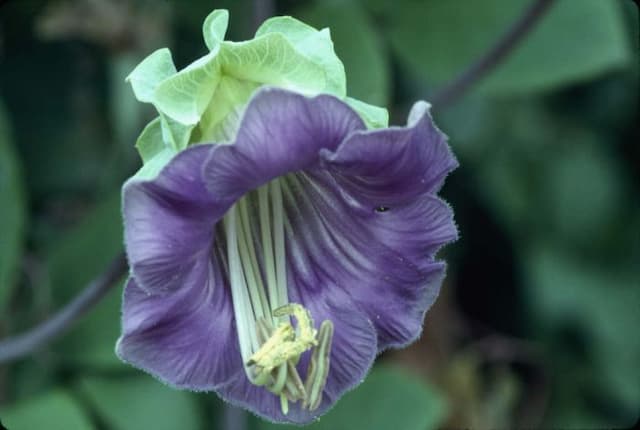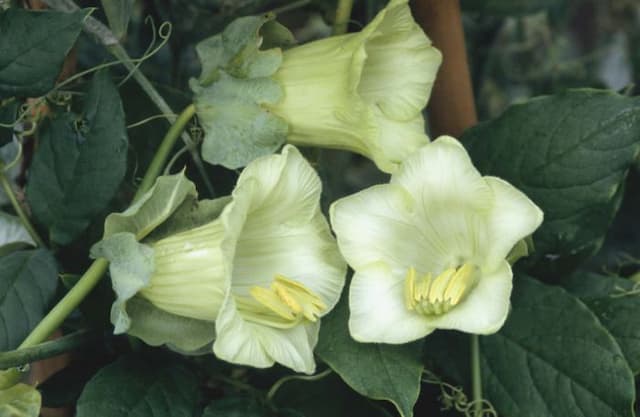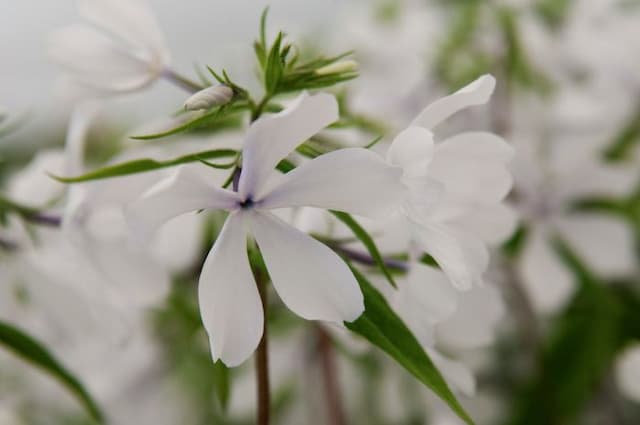Woodland Phlox Phlox divaricata 'Clouds of Perfume'

ABOUT
The Woodland Phlox 'Clouds of Perfume' is a perennial plant known for its delightful fragrance and attractive appearance through spring and early summer. This variety features a dense mound of dark green, oblong leaves that act as an elegant backdrop to its standout feature: the flowers. The blooms are abundant, covering the plant with a profusion of soft blue, lavender, or sometimes almost white flowers with five petal-like lobes. Each flower is delicate and tubular, with a slightly star-shaped appearance due to the way the lobes spread outwards. These flowers come together in rounded clusters, emitting their signature sweet scent, which can often be detected from a distance, adding to the charm of garden spaces. The fragrance is particularly prominent on warm, still days. While the foliage of 'Clouds of Perfume' is somewhat low and spreading, it creates an attractive ground cover, forming a verdant cushion long before the flowers bloom. This Woodland Phlox is a favorite among gardeners for its ability to bring a visually soothing and aromatic element to shaded or semi-shaded garden areas.
About this plant
 Names
NamesFamily
Polemoniaceae
Synonyms
Woodland Phlox, Wild Blue Phlox, Wild Sweet William
Common names
Phlox divaricata 'Clouds of Perfume'.
 Toxicity
ToxicityTo humans
The Woodland Phlox is not commonly known to be toxic to humans. However, individual sensitivities can vary, and it is generally advised not to ingest any ornamental plants due to the potential for an unpredictable reaction.
To pets
The Woodland Phlox is generally not considered poisonous to pets. However, as with any non-food plant, there is always the possibility of a sensitive reaction if a pet ingests it, potentially causing mild gastrointestinal upset. It is always prudent to prevent pets from consuming plants that are not intended for their diet.
 Characteristics
CharacteristicsLife cycle
Perennials
Foliage type
Deciduous
Color of leaves
Green
Flower color
Blue
Height
1 foot (0.3 meter)
Spread
1 foot (0.3 meter)
Plant type
Herb
Hardiness zones
3
Native area
North America
Benefits
 General Benefits
General Benefits- Attracts Pollinators: Phlox divaricata 'Clouds of Perfume' is known for attracting bees, butterflies, and other beneficial insects to the garden.
- Aesthetic Appeal: It offers beautiful clusters of fragrant, blue-lavender flowers that enhance the visual appeal of garden spaces.
- Low Maintenance: Once established, it requires minimal care, making it suitable for gardeners of all skill levels.
- Drought Tolerance: This variety of phlox can tolerate periods of dry weather once it is well established, reducing the need for frequent watering.
- Native Plant Advantage: Being a native species, it is well adapted to local climates and ecosystems, which can contribute to easier care and better growth.
- Ground Cover: Its growth habit makes it an excellent choice for ground cover, thereby helping to control weeds and prevent soil erosion.
- Spring Bloom: It provides early spring blooms, helping to fill the gap after early bulbs but before summer perennials take over.
- Habitat Support: The plant offers nectar and habitat for pollinators, supporting local biodiversity.
- Versatile Landscaping: It can be used in a variety of garden settings, including woodland gardens, borders, and rock gardens.
- Deer Resistance: Phlox divaricata 'Clouds of Perfume' has a degree of deer resistance, which can be beneficial in areas with deer pressure.
 Medical Properties
Medical PropertiesThis plant is not used for medical purposes.
 Air-purifying Qualities
Air-purifying QualitiesThis plant is not specifically known for air purifying qualities.
 Other Uses
Other Uses- Phlox divaricata 'Clouds of Perfume', commonly known as the woodland phlox, can be used as a natural dye, providing a range of soft colors to fabrics when the flowers are processed appropriately.
- In some regions, the mild and pleasant fragrance of woodland phlox is used to create natural potpourris without any synthetic additives.
- The flowers of the woodland phlox can be pressed and used in flower pressing crafts to create decorative bookmarks, greeting cards, and framed botanical art.
- Some gardeners use the dense growth of woodland phlox as a living mulch to retain soil moisture and suppress weed growth around other plants.
- Woodland phlox, due to its attractive flowers, is sometimes used in edible landscaping, though caution should be taken as not all parts of the plant are safe to ingest.
- The plant can function as an indicator species in woodland restoration projects, its presence suggesting a healthy, undisturbed woodland ecosystem.
- Because of its clumping habit and abundant spring blooms, woodland phlox can be effective in stabilizing soil on slopes or banks to prevent erosion.
- The plant can serve an educational purpose, demonstrating plant propagation techniques to students and novice gardeners, as it can be propagated through division, cuttings, or seed.
- Woodland phlox's tendency to attract butterflies and hummingbirds can be used by photographers and nature enthusiasts to capture wildlife images in gardens and natural settings.
- As a part of themed gardens, such as a 'moon garden', woodland phlox can contribute its evening fragrance, enhancing the sensory experience of nighttime garden visitors.
Interesting Facts
 Feng Shui
Feng ShuiThe Wild Blue Phlox is not used in Feng Shui practice.
 Zodiac Sign Compitability
Zodiac Sign CompitabilityThe Wild Blue Phlox is not used in astrology practice.
 Plant Symbolism
Plant Symbolism- Harmony: Phlox symbolizes harmony and balance, which can be attributed to its growth in clusters, showcasing unity and a balance in nature.
- Unity: The clustering nature of phlox flowers also represents unity, signifying coming together and forming strong social bonds.
- Agreement: The easy-to-grow aspect of the Phlox divaricata reflects an essence of agreement and adapting to various environments, which in human terms can translate to being agreeable in relationships or social settings.
- Proposal: In Victorian flower language, offering a bouquet of phlox could be seen as a proposal or a way of expressing the desire for the recipient to join in partnership, whether in business or love.
- Dreaminess: The 'Clouds of Perfume' variety particularly brings a dreamy aspect to its symbolism because of its soft and abundant flowers that can create an ethereal, cloud-like appearance, which might be associated with imagination and fantasy.
- Sweet Dreams: The fragrance of 'Clouds of Perfume' may signify sweet dreams as the pleasant scent has a calming effect and can be associated with peaceful sleep and relaxation.
 Water
WaterThe Woodland Phlox (Phlox divaricata 'Clouds of Perfume') prefers consistent moisture, especially during its growing season in spring and early summer. Water this perennial deeply once a week, providing about one to one and a half gallons of water per square yard of soil, ensuring that the water penetrates the soil rather than running off the surface. During periods of drought or extreme heat, you might need to water twice a week. However, be mindful not to overwater as the plant is susceptible to root rot if the soil becomes waterlogged. It's best to water early in the morning to allow foliage to dry out during the day, reducing the risk of fungal diseases.
 Light
LightWoodland Phlox thrives in partial shade to full shade conditions. The ideal spot for the plant is beneath deciduous trees where it can receive dappled sunlight or in a spot that gets morning sun and afternoon shade. This plant does particularly well in areas that mimic its natural woodland habitat, avoiding the harsh midday sun which can scorch its leaves.
 Temperature
TemperatureWoodland Phlox is hardy and does well in a wide temperature range, typically between 60°F and 75°F. It can survive short periods of colder weather, down to about 40°F, and can tolerate summer temperatures up to around 80°F. The ideal growing conditions involve cool to mild temperatures, reflecting its natural undergrowth habitat.
 Pruning
PruningPrune Woodland Phlox after flowering by deadheading spent blooms to encourage a second round of flowering and to maintain plant appearance. In late winter or early spring, cut back any dead or damaged stems to make way for new growth. Pruning is not only for aesthetic purposes but also promotes good air circulation, which helps prevent fungal diseases. The best time for major pruning is in the spring before the plant starts its active growth.
 Cleaning
CleaningAs needed
 Soil
SoilWild Blue Phlox prefers well-drained, humus-rich soil with a neutral to slightly acidic pH around 6.5 to 7.0. A good soil mix for this plant would be comprised of equal parts garden soil, compost, peat moss, and perlite to ensure good drainage and fertility.
 Repotting
RepottingWild Blue Phlox, being a perennial garden plant, does not typically require repotting as it is not commonly grown in containers. Instead, it is planted directly into garden beds where it can spread naturally.
 Humidity & Misting
Humidity & MistingWild Blue Phlox thrives best in outdoor conditions where humidity is naturally regulated. Typical garden humidity levels are adequate for this plant, without the need for specific adjustment or measurement.
 Suitable locations
Suitable locationsIndoor
Place in bright, indirect light; keep soil moist.
Outdoor
Plant in partial shade; mulch soil to retain moisture.
Hardiness zone
3-8 USDA
 Life cycle
Life cyclePhlox divaricata 'Clouds of Perfume', commonly known as woodland phlox, begins its life cycle as a seed, which upon germination develops a small root system and a rosette of basal leaves. In the following growing season, the herbaceous perennial establishes a stronger root system and vegetative growth, with stems branching out and leaves maturing. Flower buds form as the weather warms, usually in late spring to early summer, culminating in the blooming of fragrant, blue or lavender flowers which attract pollinators and are key for the continuation of the species. After pollination, the flowers develop into small seed capsules, which when mature, release seeds for dispersal, continuing the plant's reproductive cycle. Post-bloom, the plant undergoes a period of senescence where above-ground foliage dies back, while the below-ground parts, particularly the root system, survive through the winter. With the onset of spring, woodland phlox emerges again, repeating the life cycle by sending up new growth from its overwintering roots.
 Propogation
PropogationPropogation time
Spring to early summer
Propogation: Phlox divaricata 'Clouds of Perfume', commonly known as Woodland phlox or Wild blue phlox, is commonly propagated through division, which is best performed in early spring or autumn. When the plant is not actively blooming and temperatures are cooler, dig up the entire clump, ensuring you have a good amount of roots. Gently separate the clump into smaller sections, making sure each section has several shoots and a portion of the root system. These sections can then be immediately replanted in well-prepared soil, spaced about 12 to 18 inches (approximately 30 to 45 centimeters) apart to ensure they have enough space to grow. Water the new plants well to help establish them. Division helps maintain plant vigor and is a quick way to propagate and spread the serene beauty of the 'Clouds of Perfume' throughout your garden.









